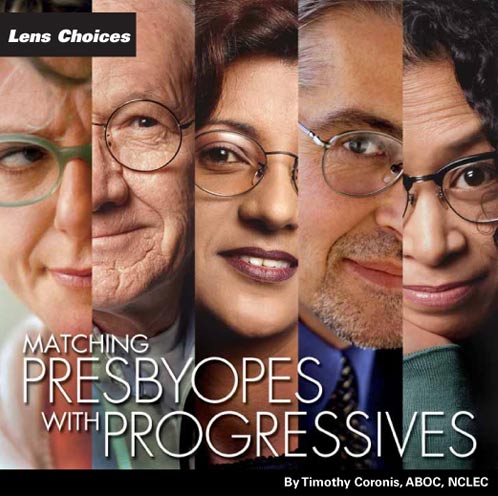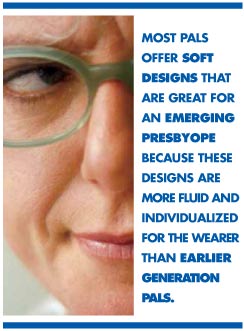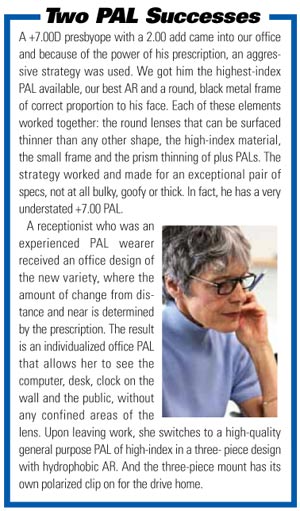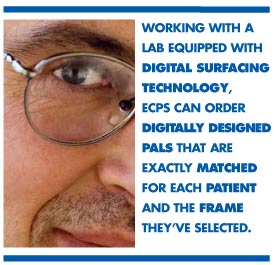
Progressive addition lenses (PALs) improve the lives of countless patients who have developed presbyopia. With their ability to correct vision at a variety of distances and with presbyopia a natural inevitability for most, PALs are an attractive vision correction option for a growing segment of the aging population.
Today there are more PAL designs available than ever before, giving eyecare professionals (ECPs) more options to provide the best vision to their presbyopic patients. Yet the ever-expanding array of options and the wide range of price points can easily become confusing. Should ECPs encourage patients to wear the newest PALs made with digital surfacing, freeform technology and wavefront design, or should they simply stick with the older, established PAL designs the patient may be used to wearing? Is a general purpose PAL right for all situations or does the patient also need a specialized PAL for office work, sports or playing the piano? Should an emerging presbyope receive the same lens design as a more experienced presbyope?
With so many choices, it’s more important than ever for ECPs to stay current with their PAL knowledge to make the best recommendations to their presbyopic patients. This involves judgment and expertise. It’s not so much a matter of finding the best PAL as it is finding the best match for the wearer.
DETERMINING PATIENT NEEDS
Experienced opticians have long combined the function of the lenses with the fashion of the frame in a carefully chosen pair of spectacles. Today’s ECPs can carry this concept further, matching their presbyopes to PALs of the most suitable design, material and treatment.
The PAL selection process usually begins with a discussion of the patient’s occupational and recreational activities and the visual tasks that accompany them. Lifestyle questionnaires can capture basic information, but it’s often helpful to probe a bit further to find out how the patient’s visual needs might require specific solutions that change throughout the day. For instance, your patient may like to wear a fashionably small frame at the office, but then switch to wraparound sunglasses when they play tennis on the weekend. In this case, a short-corridor PAL would work best for the office and an eightbase, polarized PAL with optics customized for wraps would be the ideal second pair.
While no two patients are alike, grouping presbyopic patients into the following categories makes it easier for the ECP to narrow down the PAL selection process.

EMERGING PRESBYOPES
Emerging presbyopes are generally the ideal PAL candidates, having no bifocal habits to unlearn, but they may be coming to you out of frustration with their inability to see things up close and may be sensitive about needing “old person” glasses.
PALs should be presented as a solution for correcting vision for a variety of distances. However, the wearer won’t see properly if they misuse the PAL. While PALs have to match the wearer, the lenses and the wearer’s expectations need to match, too.
Most PALs offer soft designs that are great for an emerging presbyope because these designs are more fluid and individualized for the wearer than earlier generation PALs. The emerging presbyope has choices, so emphasize that fact.
Although there may be no getting around the loss of elasticity of the crystalline lens and the accompanying presbyopia, there are many options to address this need, from lightweight materials and sleek frames, to PALs of all sizes and uses.
Don’t hesitate to recommend the best lenses, materials and treatments, because your customer will enjoy being offered first class options, materials and service. You will be most successful starting with the best option, with a less expensive option available, should cost remain an issue. Be prepared for curve balls, though, since you will also run into a few emerging presbyopes who have no idea eyeglasses are priced like other quality items.
These will be the occasional exception to the rule because once the benefits are made clear, most patients will realize that PALs are a really good value, delivering vision correction in a variety of circumstances.
BIFOCAL AND TRIFOCAL WEARERS
Bifocal and trifocal wearers become potential converts to progressives as their need for intermediate correction increases. These patients can benefit from PALs and can be fit in PALs designed especially for them. These PAL designs feature a hard design, giving the wearer a window like their lined lenses with a progression of add power.
Bifocal wearers benefit from an intermediate zone absent from their current lens, so present PALs as an improvement, offering benefits that are obvious such as an absence of lines and less image jump, as well as less obvious benefits such as wider range of availability in many materials and treatments. Prescriptions of plus power can be made thinner in PALs than bifocals, ensuring a sleeker profile and more secure fit in the frame. Again, determine patient expectations and present PALs accurately before converting bifocal wearers. Most PALs offer a non-adapt warranty, offering a free exchange for bifocals if the wearer cannot tolerate the PAL.
OTC READERS WEARERS
For millions of presbyopes, buying over-the-counter readers is the first stop on the road to wearing PALs. Of course, OTC readers have severe limitations such as one standard PD and prism resulting from this, and lower quality lens material and processing, but they may allow some presbyopes to postpone PALs, at least for a while.
Remember, every patient who wears OTC readers is a potential candidate for PALs. Explain to them the benefits of PALs and try engaging them in a dialogue about their visual needs. A presbyope with two pair of readers of different powers, one for woodworking and another for reading, might have never considered progressives. This presbyope might have walked over to the drugstore after his exam to buy more readers. Through conversation, the benefits of a progressive design might come to light, resulting in a more sophisticated solution, the PAL, not to mention less fumbling with multiple pairs of readers.

EXPERIENCED PAL WEARER
This individual has worn progressives before. Find out how they liked their last pair of PALs. If they wore a hard design with clear delineation and a confined view, a new softer design PAL would be a nice step forward. Or maybe they have already used a newer, softer design. Did they have only one pair? Could you help them with a polarized pair of progressive sunglasses? Do they find themselves doing activities for a few hours at a time, like using the computer? If so, an office PAL, also known as a near-variable focus lens, would make a useful second pair.
What about photochromics? Did you explain to the patient that photochromics are not a substitute for sunglasses, but instead can be worn in a variety of light conditions? How about a UV treatment? Some UV treatments turn lenses yellow. A better solution might be a high-index material that filters UV, combined with an AR treatment.
The experienced PAL wearer may have no idea how many lens options are available and they may have no idea about frame options. How about a three-piece drilled mount? Is your customer aware that their new PALs could be a highindex photochromic, AR pair, in a modern three-piece drilled mount?
Handled carefully and graciously, experienced PAL wearers give us an opportunity to offer improvements and evolved designs to the wearer.
MYOPES
A -2.00 myope is often in the habit of taking their glasses off to read, so the reading portion of their PAL will not be its strongest feature. The near portion of their PAL may approach plano power. This patient is used to seeing well up close, so their PAL is only going to improve the distance. PALs should be presented as an alternative to glasses on and off for a mildly myopic patient and not something to improve vision at all distances, the way they would for someone with a -5.00 and a 2.00 add. Clarifying expectations in the case of a -2.00 myope prevents disappointment, reduces remakes, and reduces frustration for the dispenser.
HYPEROPES
Hyperopes may use their eyes a little differently than myopes, who can frequently see fine up close. Hyperopes may not have any zone of comfortable vision without their spectacles.
Some experienced opticians fit PALs a millimeter high on hyperopes to get them into the plus power sooner. Select appropriate frames for myopes, keeping in mind that round shapes can be surfaced thinner than any other shape. Rectangular frames, for example, mean this presbyope gets a thicker PAL. When PALs have plus in the distance power, they undergo the prism thinning process, which helps reduce thickness. It is equal in both lenses so no imbalance is created.
EMMETROPES
PALs providing correction for emmetropes are going to help with intermediate and near only, so it is necessary to find out if an all purpose PAL is the right choice, worn all day, or whether an office design is a better option, supplying only intermediate and near correction, and worn on an as-needed basis.
OFFICE DESIGNS
Using a computer with a general purpose PAL can become uncomfortable after a few hours because wearers find themselves holding their head back a little to use the intermediate zone of the lens. A more specialized lens emerged to fit this need, the office design, a PAL made specifically for the distances involved in working on a computer and desk. Office PALs offer readers their full reading prescription with a sizeable window above it for intermediate use, for keyboard and monitor viewing, respectively.
Newer office PALs incorporate softer designs and progressions of power specific to particular prescriptions. All PALs, but most especially office designs should be optimized with AR treatments to further reduce eyestrain associated with computer monitor use and to minimize glare from overhead lighting.
Since office PALs typically have no distance zone, they cannot function as general purpose PALs and are sold as second pairs. Although some dispensers might feel awkward suggesting more than one pair of PALs for the same presbyope, it should be remembered that it would be appropriate for the presbyope to have more than one pair of shoes and even have some shoes more specialized than others, such as a pair of loafers and a pair of tennis shoes.
Office PALs are not computer-only spectacles. They provide a solution whenever near and intermediate distance correction is needed, such as when playing the piano to see the keyboard and music.
SHORT-CORRIDOR DESIGNS
Short-corridor designs were introduced in the late ’90s as a way to deliver PAL performance in a small or oval-style frame. These PALs feature a corridor as small as 18mm and fitting heights ranging from 18mm to as low as 13mm, depending upon the manufacturer’s design.
Although some early short-corridor designs were merely squashed down versions of conventional PALs, more recent designs are specifically tailored to provide enhanced PAL performance in small frames, with digital designs being created in short-corridor form. The biggest advance in short-corridor designs has been the improvement of the intermediate zone and softening of the overall design.
The challenge for the ECP is to find a short-corridor PAL that will allow patients to choose from a full range of small frames, while still providing plenty of reading area. A good short-corridor PAL should offer excellent reading vision even at low fitting heights, soft design binocularity, low aberration and reduced astigmatism.
Although good things can come in small packages, it may be necessary to go bigger for your presbyope to get all the benefits from their PAL. For example, short-corridor designs might be poor choices for headmovers, but are excellent for experienced PAL wearers.

DIGITALLY SURFACED PALS
The biggest advancement in PALs in recent years has been the development of digitally surfaced lenses. Optical labs can now use special Rx calculation management software to convert a progressive surface design into a set of numbers called a points file or cutting file. This data can then direct a CNC surface generator equipped with a diamond cutting tool to mill a lens design directly onto a lens or mold surface. With the right generator, software and cutting file, labs can modify the back surface of a semifinished lens while cutting the prescription curves, enabling it to produce aspheres, atorics and complex surfaces.
Digital technology is creating new opportunities for ECPs and wearers. Working with a lab equipped with digital surfacing technology, ECPs can order PALs that are exactly matched for each patient and the frame they’ve selected.
MORE PALS, MORE OPTIONS
No one looks forward to becoming presbyopic. In fact, some patients may dread the prospect.
Yet it’s actually a great time to be a presbyope. With so many progressive lens options available today, there are visual and cosmetic solutions for practically everyone. All it takes for each patient to find the best PAL for them is a knowledgeable and experienced eyecare professional to open their eyes to the possibilities.
Timothy Coronis is a certified optician who lives and works in Keene, N.H. He is also an American Board of Opticianry certified technical speaker. He can be reached at [email protected].











